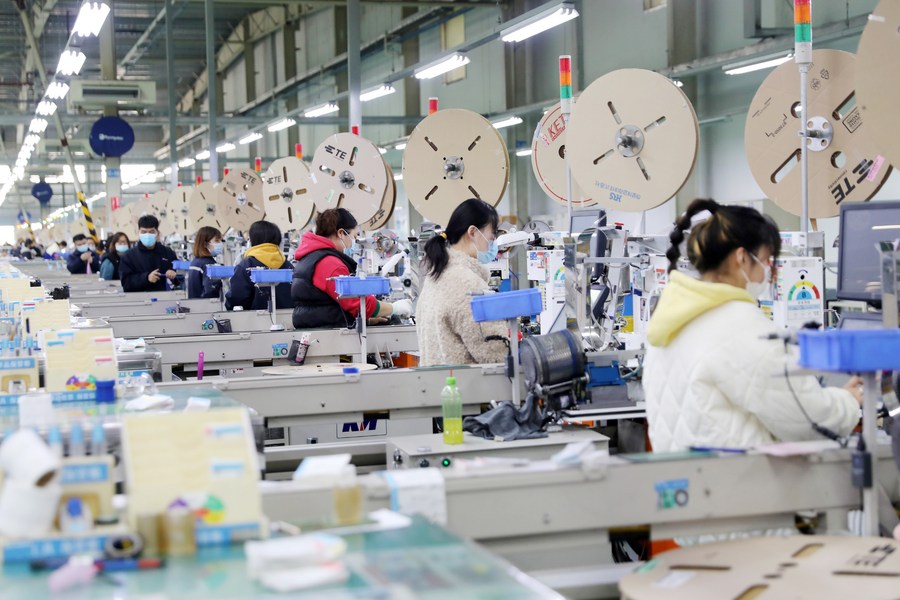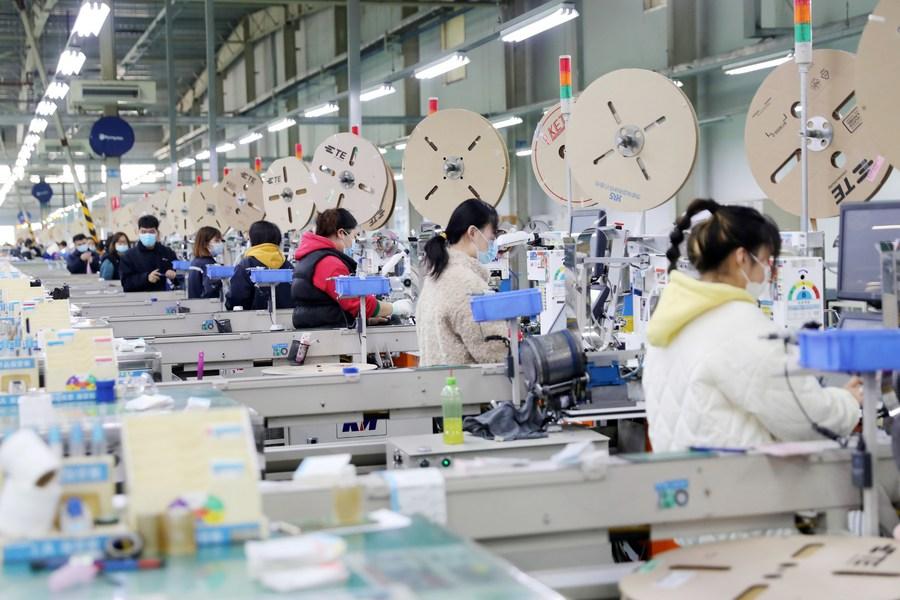
Workers work on an assembly line of electronic products at a company in Huaibei, east China's Anhui Province, Jan. 1, 2022. (Wan Shanchao/Xinhua)
BEIJING, Feb. 20 (Xinhua) -- China's cabinet urged a raft of new relief policies earlier this week, which has offered a glimpse of hope for smaller businesses to grapple with cash crisis, experts said.
According to a statement released after the State Council's Executive Meeting, China will extend income tax relief to the industrial and services sectors and expand tax and fee cuts policies to low-profit small businesses and self-employed households.
Issuance of inclusive loans to micro and small businesses will be encouraged by the central bank.
"Those measures are very targeted to stimulate market vitality and bolstering economic impetus," said Ma Bin, the executive vice president of China Association of Small and Medium Enterprises (CASME). She added that they are all directed to relieve the cash flow problems and precisely address the pain points of businesses.
This year, micro, small, and medium-sized enterprises that purchase new equipment worth above 5 million yuan (about 786,000 U.S. dollars) and with a 3-year depreciation period are entitled to a one-off deduction of total purchase costs from taxable income, or a 50 percent deduction for such purchases of equipment with a depreciation period of four, five or ten years, according to the statement.
The move lessens the income tax burdens of smaller businesses. It increases their cash flow to ensure they can stay afloat and to promote investment and expansion, according to Li Xuhong, a researcher with the Beijing National Accounting Institute.
Since last year, China has cranked up financial policies to tackle the cash strain, an issue that has long been troubling smaller businesses.
By the end of last year, outstanding inclusive loans to small and micro businesses issued by banking institutions topped 19.1 trillion yuan, surging 24.9 percent year on year, according to the China Banking and Insurance Regulatory Commission.
Along with other efforts to secure supplies, keep prices stable and effectively prevent and control the epidemic, business confidence and expectations of small and medium-sized firms are perking up.
The Small and Medium Enterprises Development Index, released by CASME, was 89.4 in January, although still remaining below the boom-bust line of 100, continuing a rise for three consecutive months and nearing the level in the same period in 2021.
The index tracks the estimation and expectations of small and medium-sized companies on the industry's operation and their firms' production and operation situations, based on data from 3,000 firms in eight sectors.
"As Spring Festival holiday approaches, many companies normally allow their employees to take holiday in advance in January, resulting in a stalled production, as revealed in the data of 2019 and 2020. We attributed this January's stronger performance mostly to policy support," Ma said.
However, Ma called for more attention to the remaining cost and capital issues in this year's policy maneuver.
"Despite the easing of bulk commodity prices from a high level, profit disparities between the upstream and downstream enterprises remain grim," Ma said. She noted that most small and micro firms are in the downstream industries, with weaker abilities to pass costs on to consumers and negotiate prices.
Looking ahead, Ma said more efforts should be made to accelerate the implementation of policies, step up financial backstop and strengthen targeted support to small and micro firms and individually-run businesses.




 A single purchase
A single purchase









